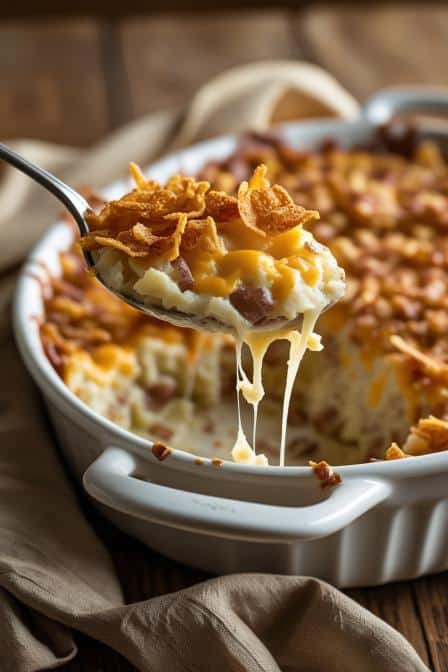Ever stumbled upon a dish so cozy and comforting that it feels like a warm hug from the inside out? Funeral potatoes might just be that soul-soothing treasure. Despite its somewhat morbid name, this casserole has nothing to do with gloom—it’s a beloved, creamy, cheesy concoction that has found its way into hearts and tables across the American West and beyond. But what exactly makes funeral potatoes so special? Let’s dive into the cheesy layers of this classic and uncover why it’s more than just a casserole.
What Are Funeral Potatoes and Why Are They Special?
Funeral potatoes, sometimes known as cheesy hash brown casserole, are a rich, baked dish primarily made from hash browns, cheese, cream soup, and a crunchy topping—usually cornflakes or breadcrumbs. Originating from Mormon communities in the Intermountain West, the dish earned its nickname because it’s traditionally served at post-funeral gatherings, offering easy comfort to grieving families. But don’t be fooled: its appeal is universal.
What makes it unique is this marriage of simple, humble ingredients into a creamy, crunchy, savory delight. The magic lies in the textures: soft, cheesy potatoes underneath and a golden, crispy top that crunches with every forkful. The dish is also incredibly versatile, allowing endless tweaks—be it extra cheese, crispy bacon, or a touch of spice. Plus, it’s an absolute crowd-pleaser, perfect for potlucks, holiday dinners, or anytime you want a big bowl of warmth.
Ingredients & Substitutions
Getting the ingredients right is essential for nailing the authentic taste and texture of funeral potatoes. But don’t worry, there’s room for swaps to accommodate different diets or ingredient availability. Here’s a handy table to get started:
| Ingredient | Purpose | Substitutions | Selection Tips |
|---|---|---|---|
| Frozen Hash Browns | Base potato texture | Fresh shredded potatoes (parboiled) | Frozen hash browns offer consistency and ease; fresh can be used for better texture but must be pre-cooked to avoid sogginess |
| Cream of Chicken Soup | Creamy binder and flavor | Cream of Mushroom Soup (vegetarian option) | Canned soup is classic for convenience; homemade white sauce offers fresher taste and control over saltiness |
| Sour Cream | Creaminess and tang | Greek Yogurt (healthier, thicker) | Full-fat sour cream enriches flavor; lighter options alter creaminess and texture |
| Shredded Cheddar Cheese | Flavor and meltiness | Monterey Jack, Mozzarella (milder or stretchier) | Sharp cheddar offers tang and depth; milder cheeses soften the flavor |
| Butter | Richness and helps crisp topping | Olive oil or margarine | Butter browns nicely for topping; oil can substitute but flavor differs |
| Cornflakes | Crunchy topping | Panko breadcrumbs, crushed Ritz crackers | Cornflakes create a sweet crunch; panko is lighter and crispier |
| Onion Powder | Adds subtle savory depth | Fresh minced onion | Powder blends seamlessly; fresh onion adds texture but may affect moisture |
| Garlic Powder | Flavor enhancer | Fresh minced garlic | Powder is subtle; fresh adds pungency and texture |
| Salt and Pepper | Basic seasoning | Sea salt, kosher salt | Adjust saltiness carefully, especially with canned soup |
When selecting cheese, go for freshly shredded rather than pre-shredded. The anti-caking agents in pre-shredded cheese can cause it to clump and not melt as smoothly. Also, choose a full-fat cheese for richer melt and mouthfeel.
Step-by-Step Instructions
The beauty of funeral potatoes lies in their simplicity, but every step matters to avoid a mushy or bland casserole. Here’s the expert way to get it right.
Step 1: Prepare Your Ingredients
If you’re using fresh potatoes, shred them and rinse to remove excess starch, then parboil for 3-5 minutes to prevent sogginess. Frozen hash browns can be used straight from the freezer but make sure to thaw and drain any excess water.
Step 2: Mix the Base
In a large bowl, combine the hash browns, cream of chicken soup, sour cream, shredded cheddar, onion powder, garlic powder, salt, and pepper. Stir gently but thoroughly to combine. The mixture should be creamy but not soupy.
Expert Tip: Avoid overmixing, as it can break down the potatoes and result in a gluey texture.
Step 3: Transfer to Baking Dish
Grease a 9×13 inch casserole dish with butter or non-stick spray. Pour in the mixture evenly and smooth the surface with a spatula.
Step 4: Prepare the Topping
Melt butter in a small bowl, then stir in crushed cornflakes until evenly coated. Spread the topping evenly over the potato mixture.
Common Mistake: Don’t skip butter in the topping. It’s the key to golden, crispy edges.
Step 5: Bake
Preheat the oven to 350°F (175°C). Bake the casserole uncovered for 45-55 minutes until the top is golden brown and crispy, and the edges are bubbly.
Step 6: Rest and Serve
Allow the casserole to cool for about 10 minutes before serving. This lets it set, making it easier to cut into squares and scoop.
Variations
- For a smoky twist, stir in cooked, crumbled bacon.
- Add a cup of diced green chilies for a subtle heat.
- Swap cream of chicken for cream of mushroom for a vegetarian version.
- Sprinkle fresh herbs like chives or parsley on top before serving for freshness.
Cooking Techniques & Science
Why does this casserole work so well? It’s a harmony of moisture control, texture contrast, and flavor layering.
The Science of Creaminess and Crunch
The cream of chicken soup and sour cream bring moisture and richness, ensuring the potatoes don’t dry out. The cheese melts into the potatoes, creating gooey pockets that keep every bite luscious. Meanwhile, the buttered cornflake topping dries out and crisps during baking, providing a delightful crunch that contrasts with the creamy interior.
Texture Matters
Using frozen hash browns is a shortcut, but fresh shredded potatoes, if parboiled and dried properly, add a more robust texture and fresh flavor. The parboiling partially cooks the potatoes, preventing them from releasing excess water during baking, which would otherwise turn the casserole mushy.
Why Baking Uncovered?
Baking uncovered lets moisture evaporate from the top, allowing the crust to crisp up. Covering would trap steam and lead to a soggy topping.
Storage and Reheating
Funeral potatoes keep well in the fridge for 3-4 days. Cover tightly with foil or plastic wrap. To reheat, place individual portions in a microwave or warm the whole casserole at 350°F for 20-25 minutes until heated through and the topping crisps back up.
Freezing is possible but can affect texture. Wrap tightly and freeze for up to 2 months. Thaw overnight in the fridge before reheating.
Tools That Make a Difference
- A quality non-stick casserole dish or a well-seasoned cast iron pan ensures easy serving.
- Sharp graters for fresh cheese and potatoes improve melt and texture.
- A food processor with a shredding attachment can speed prep but beware of over-processing.
Serving & Pairing Suggestions
Funeral potatoes are usually a side dish, but they can shine as a main course with the right pairings.
Presentation Tips
Scoop generous portions into warm bowls or plates. Sprinkle fresh herbs on top for a pop of color and freshness. Adding a dash of smoked paprika or black pepper to the topping before baking can boost visual appeal.
Complementary Dishes
- Protein: Roasted turkey, ham, or baked chicken work beautifully. The creamy potatoes balance the savory, salty meats.
- Vegetables: A crisp green salad or steamed green beans provide textural contrast and freshness.
- Drinks: A full-bodied white wine like Chardonnay or a light beer can cut through the richness.
Best Time to Serve Funeral Potatoes
Although traditionally linked to funerals and comfort meals, funeral potatoes fit perfectly on holiday tables—Thanksgiving, Christmas, Easter. Their ease makes them ideal for potlucks and large family gatherings. Honestly, whenever you crave something warm, cheesy, and downright satisfying, this casserole is your go-to.
Conclusion
Funeral potatoes aren’t just a casserole; they’re a tradition wrapped in cheesy goodness. Their creamy, crunchy texture and nostalgic roots make them a comforting staple in American cuisine. Whether you stick to the classic recipe or tweak it with bacon, chilies, or fresh herbs, mastering this dish means you’ve got a dependable crowd-pleaser on your hands.
Remember: quality ingredients, careful moisture control, and the right balance between creamy and crunchy textures make all the difference. Don’t be afraid to experiment a little—sometimes adding a pinch of spice or a different cheese can elevate the casserole from good to unforgettable.
FAQs About Funeral Potatoes
Q1: Can I make funeral potatoes ahead of time?
Absolutely! Assemble the casserole, cover it tightly, and refrigerate overnight. Add the topping just before baking.
Q2: Is there a vegan version of funeral potatoes?
Yes. Use dairy-free sour cream and cheese alternatives, replace cream of chicken soup with a vegan cream soup, and substitute butter with plant-based margarine.
Q3: What’s the best cheese to use?
Sharp cheddar is classic for flavor depth, but Monterey Jack or Colby can be used for a milder taste.
Q4: How do I prevent soggy potatoes?
Use thawed and well-drained frozen hash browns or parboiled fresh potatoes. Avoid overmixing and bake uncovered.
Q5: Can I add other vegetables?
Yes, diced bell peppers, green chilies, or mushrooms can add flavor and texture, but keep moisture in mind to avoid sogginess.
This casserole is a testament to how simple ingredients, when combined thoughtfully, create magic. Funeral potatoes bring that magic to your table—warm, cheesy, crunchy, and downright comforting. Give it a try, and you might just find yourself craving it again and again.

